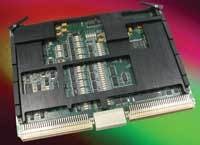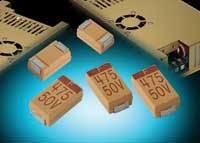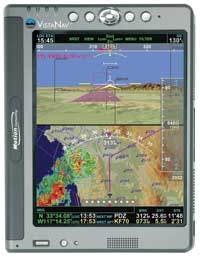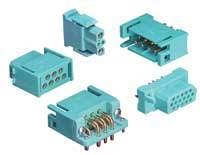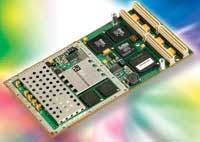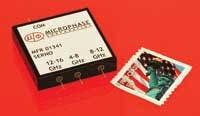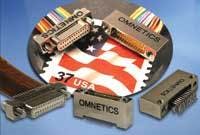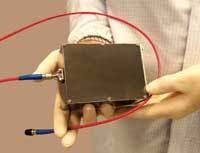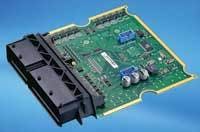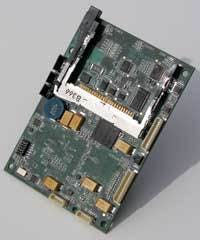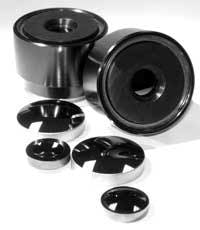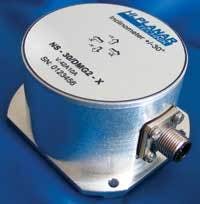Rugged, low power 6U VMEbus board
Aitech Defense Systems, Inc. in Chatsworth, Calif., is offering a rugged, low-power 6U VMEbus board that provides several I/O capabilities, including ARINC-429, analog-to-digital, digital-to-analog, audio, and discretes. The I/O capabilities are for system integrators who need I/O for a many sensors and actuators in airborne applications such as manned and unmanned aerial vehicles (UAVs) as well as helicopters. Each of the C437’s analog, digital, and discrete I/O sections has independent power and ground domains, where each signal is fully isolated from one another to maintain signal integrity and to minimize cross-coupled noise. This enables high fidelity, low noise floor analog-to-digital and digital-to-analog conversions, while minimizing digital crosstalk and interference. I/O components of the new board include 24 AEEC-compliant ARINC-429 channels that support both high and low speed configurations (16 receive and eight transmit), 60 single-ended discrete inputs, two differential inputs and 41 single-ended discrete outputs, in addition to four opto-isolated, -10V to 10 volts, 16-bit differential analog inputs and four -10 to 10 volts differential analog outputs. An MP3 player with stereo audio output, coupled with dedicated Flash and SRAM memory, enables the board to store and playback pre-recorded audio messages. The new C437 can decode and play various formats including MP3+V, WAV, PCM and MPEG 1 and 2 audio layer 3 files, as well as run-time messages. For more information contact Aitech online at www.rugged.com.
Fused tantalum capacitors
AVX Corp. in Myrtle Beach, S.C., is offering solid tantalum capacitors for a variety of applications, including unmanned vehicles. Solid tantalum capacitors are very reliable and can operate in a wide variety of environmental conditions. Because of this high reliability, tantalums are seeing increased use in more harsh conditions: temperatures, voltages, or current surges in excess of recommendations. These conditions may not allow the capacitor to take advantage of the inherent self-healing mechanism. As a safety factor in these applications, AVX has developed a new tantalum capacitor with a built in fuse that will open if the capacitor starts to draw excess current. The standard fused tantalum on the market today uses a bi-metallic fuse wire. The wire fuse limits flexibility in design and significantly increases the Equivalent Series Resistance (ESR) of the complete package, limiting their usefulness in power supply filtering applications. The AVX (TBW) fused capacitor replaces the fuse wire with a low ESR, extremely reliable thin film fuse. This fused design allows for capacitors to be Weibull graded per Mil-PRF-55365 as well as surge current tested. TBW fused tantalum capacitors come in standard EIA case sizes C, D, and E and do not compromise the standard capacitance ratings available in non-fused designs. For more information contact AVX online at www.avx.com.
Multifunction portable flight display for UAV reconnaissance
Mercury Computer Systems in Chelmsford, Mass., is offering the VistaNav multifunction portable flight display (MFD) with three-dimensional synthetic vision. The backup navigation system helps pilots to visualize surrounding terrain while in flight. The device includes 3-D synthetic vision, HITS flight path guidance, 3-D terrain views, and 3-D approach display. The unit’s 3-D synthetic vision substantially improves situation awareness and is a key technology for the future of general aviation and UAV reconnaissance. The VistaNav Version 1.6 system includes patent-pending radar vectors functionality providing 3-D guidance during non-standard routings such as radar vector navigation or course deviations around traffic and weather. VistaNav uses several sensor data sources and integrates several databases to ensure ground-to-air support and 3-D full-terrain views in real time. VistaNav-UAV can be combined with the Mercury XB computing platform and customized to build scalable UAV ground stations, using synthetic vision to reconstruct terrain independent of weather. The VistaNav software can serve as a UAV ground station subsystem when combined with Mercury XB computing platforms, or as a portable navigation system when combined with a mobile computer and a Mercury-developed inertial navigation unit (INU). The VistaNav-GA system includes an INU featuring 3-D solid-state inertial sensors, a WAAS-enabled (Wide Area Augmentation System) GPS receiver, and a Bluetooth wireless interface. The unit is mounted inside an aircraft and communicates through a wireless interface using a tablet PC mobile computing platform (MCP). The MCP has a high-resolution 5-by-8-inch LCD display with a navigation user interface that enables pilots to manage all phases of flight, from preparation to parking. For more information contact Mercury online at www.mc.com.
Miniature power/signal connector for unmanned vehicles
The Dragonfly series connectors from Positronic Industries in Springfield, Mo., is for use in applications such as unmanned vehicles that require a high-reliability miniature connector, which offers signal and/or power contacts. The Dragonfly offers contact current ratings of 20 amperes continuous for size 16 contacts. Size 20 contacts are rated at 12 amperes when used with 18 awg wire. Dragonfly size 16 contacts have been tested to 10,000 mating cycles. See catalog for details. Dragonfly features include several package sizes with an integral quick latch locking system; crimp contact and PCB terminations; closed and open entry female contacts; and a variety of accessories. For more information, contact Positronic Industries online at www.connectpositronic.com.
Two- and four-channel rugged IF receivers for unmanned vehicles
ICS Signal Processing in Ottawa is offering the ICS-8554 four-channel rugged IF receiver and ICS-8552 two-channel rugged IF receiver for software defined radio (SDR) applications in demanding environments. Built around the PCI mezzanine card (PMC) form factor, each provides A-D and D‑D conversion, as well as field-programmable-gate-array (FPGA) resources in one lightweight, compact module for vehicle or manpack mounting. As the majority of FPGA resources are free for user-defined algorithms, systems designers are able to move the digital signal-processing element of the application-as well as the analog to digital conversion-closer to the antenna. The ICS-8552 includes an onboard TCXO in addition to two ADC/DDC/FPGA channels. The ICS-8554 trades the TCXO for two additional ADCs, and is for high channel count in vehicle-mounted systems in which a high-precision clock source is externally supplied. Both modules feature the 3M gate Xilinx Virtex-II FPGA (XC2V3000). Texas Instruments ADS5424 ADCs provide 14-bit resolution at up to 105 MHz, at temperatures from -40 to 85 degrees Celsius. Bandwidths of 10 MHz or less can be down-converted to baseband using the two GrayChip 4016s, while FPGA cores from the ICS library allow bands as wide as 40 MHz to be carried. For more information contact ICS Signal Processing online at www.ics-ltd.com.
Family of miniature multiplexers operating in at 500 MHz to 40 GHz
Microphase Corp. in Norwalk, Conn., is offering filters and multiplexers operating in the frequency range of 500 MHz to 40 GHz to accommodate the need for ever-increasing demand for smaller size, lighter weight, and improved performance aboard UAVs. The company’s miniature triplexer, for example, operates at 4 to 16 GHz with crossovers at 8 and 12 GHz. Critical parameters are minimal insertion and crossover loss while maintaining 25 decibel rejection. The size of the unit excluding the pins is 1.25 inches long by 1.25 inches wide by 0.25 inches high. The triplexer weighs half an ounce. Microphase will also custom design multiplexers, filters, switch filters, limiters, detectors, or detector log video amplifiers. For more information contact Microphase online at www.Microphase.com.
Family of metal bi-lobe nanominiature interconnects
Omnetics Connector Corp. in Minneapolis is offering a family of metal bi-lobe nanominiature interconnects that are designed to meet rugged demands while consuming small physical space. Requirements of UAVs include portability to the work area, small size and weight, and rugged for long flights that end with high-shock landings. Weather and altitude demands on the aircraft push the electrical systems requirements to new heights. Electronic requirements have new ruggedized standards to be met simultaneously with expectations of lightweight flexible cable and locking interconnect systems. With camera and detectors on board, there is increased demand for high data rates as well as high volume of video data streaming. These transmissions signals cause extreme EMI conditions that often mandate cable shielding and connector to ground requirements available in metal. Connector requirements respond to the electronic systems and have evolved into an active family of UAV ready connectors. The nanosize connectors from Omnetics exceed performance levels specifications listed in Mil-83513 and are designed to fit all requirements in the new nanoconnector specifications in Mil-32139. The connector’s low mass combined with rugged BeCu pin and socket design can withstand higher shock than older 50-mil.-pitch Micro-D connectors. The Bi-Lobe connectors are more than five times smaller than equivalent-pin-count microconnectors and weigh in at less than 12 grams compared to microconnectors that weigh more than 45 grams. For more information contact Omnetics online at www.omnetics.com.
Diode pumped 1.57-micron mini laser
RPMC Lasers Inc. in O’Fallon, Mo., is offering a diode-pumped 1.57-micron mini laser with 2 and 8 millijoules per pulse. The lasers are sealed in 0.024- and 0.043-cubic-foot packages. Pulsewidths are about 6 nanoseconds, and the beam quality is diffraction limited. Supply 12 volts of prime power and a trigger signal and the laser will operate at 30 Hz or lower, or at 100 Hz with slightly reduced energy. Waste heat moves to the base of the laser and can be conducted away. These lasers could be engineered to be significantly smaller. All solid state robust design will take considerable shock and vibration, company officials say. The laser is also available with alternate or additional wavelengths, including 3.3 microns, 1 micron, 532 and 355 nanometers, or significantly higher 1.57 microns of output. Optionally, the output can be fiber coupled. RS-232 compatible control and monitoring port can be provided. Alternate package configurations are available as well, such as separately packaged electronics. For more information contact RPMC online at www.rpmclasers.com.
Communication platform for designing UAV electronic systems
TTTech Computertechnik AG in Vienna, Austria, is offering a communication platform for the design of electronic systems in UAVs based on Time-Trigered Protocol (TTP). TTP is an open, modular, and scalable technology for the design of distributed fault-tolerant control systems. This technology is designed for efficient system reconfiguration, upgrades and growth-from UAV to UAV platform, or from mission to mission. Future add-ons and payloads can be efficiently integrated. TTP has been selected for control systems in Airbus A380 and Boeing 787 as well as for military applications e.g. FADEC for Lockheed Martin F-16. The use of certifiable commercial off-the-shelf (COTS) TTP controllers and certifiable COTS embedded software components can help reduce development time, and supports evolutionary design and incremental modernization. With TTP-Tools integrated in third-party tools, it is possible to virtually prototype and simulate UAV flight dynamics with its TTP-based control system. After the fine-tuning of control parameters and flight dynamic models, automatically generated application code can be downloaded directly to the TTP-based system. TTC 200 is a TTP-based programmable electronic control unit for sensor/actuator management, designed for low-cost cross industry by-wire applications in compliance with IEC 61508-SIL 3. The control unit is part of a compatible product family and designed for vehicles and machines that function in rough environments and at extreme operating temperatures. A 40 MHz MPC555 integrated microprocessor supplies the necessary processing power. A 38-gram TTP-IP module with digital I/O, CAN, and RS-232 can be used as a prototyping unit. Both systems interface easily to other networks. For more information contact TTTech online at www.tttech.com.
PXA270 low-power platform for mobile devices
InHand Electronics Inc. in Rockville, Md., is offering the Fingertip4, an Intel PXA270-based processor for development of handheld devices of embedding in unmanned vehicles. At the size of a credit card, the Fingertip4 is for OEM developers of embedded handheld and wireless devices who need advanced power management. The device delivers better than 500 MHz of processing power while consuming less than 0.5 watts of power. Fingertip4 incorporates peripherals such as Compact Flash, SDIO, USB host, several serial ports, and connects to LCD displays. A daughtercard interface exposes the main system bus and allows developers to support additional standard and custom peripherals. Fingertip4’s power interfaces include support for on-board lithium-ion battery charging and capacity management, with additional support for other batteries and separate power inputs for backup batteries and line voltage. InHand’s BatterySmart dynamic power management software is tightly integrated to enable developers to control low- and high-level issues related to performance and power consumption. For more information contact InHand Electronics online at www.inhandelectronics.com.
Molded lenses for long-wavelength infrared imaging
Today’s UAVs rely on a sophisticated group of sensors for determining the world around them. Many utilize new thermal imaging systems that allow a view of a target area during the night or in smoke, fog, or bad weather. The optics used in these camera systems are critical to the overall performance. LightPath Technologies Inc. in Orlando, Fla., is offering a line of Black Diamond aspheric lenses and lens systems to improve image quality without the high cost associated with diamond-turning Germanium optics. These lenses are molded from chalcogenide glass, which transmits from 1 to 14 microns in wavelength. Glass molding provides several advantages over competing technologies, including better repeatability from lens to lens, improved fidelity of the optical surface, and low dispersion. The lenses can also be used at higher temperatures than Germanium (as hot as 300 degrees Celsius) without suffering from problems with absorption. LightPath currently molds Black Diamond lenses with diameters as large as 25 millimeters. For more information contact LightPath Technologies online at www.lightpath.com.
D Series tilt sensor rated IP67 for harsh environments
Measurement Specialties Inc. in Hampton, Va., is offering the D Series inclinometer rated IP67 for use in harsh environmental conditions. The D series inclinometer is for leveling applications such as UAVs, mobile and stationary cranes, lifting platforms, mobile weighing systems and outdoor equipment. This CE-approved tilt sensor comes in a rugged aluminum package to protect the electronics from the elements. Features include IP67 rating for protection against dust and immersion in water as deep as one meter; resistance to shock and vibration; 0.001-degree resolution; high accuracy over wide temperature range due to internal compensation; meets EMC-Standard EN 61000-6-2,4; high reliability and repeatability; and is easy to use-ready for installation via connector. The device’s sensors operate on a proprietary capacitive technology using electrolytic fluid. Platinum electrodes are deposited in pairs on the base of the sensor’s cell parallel to the sensitive axis. The chamber is partially filled with an electrolytic liquid. When an alternating voltage is passed between two electrodes, the electric current will create a dispersed field. By tilting the sensor and thereby reducing the level of the liquid, it is possible to confine this stray field. Because of the constant, specific conductivity of the electrolytes a variance of resistance is formed in relation to the liquid level. For more information contact Measurement Specialties online at www.meas-spec.com.
